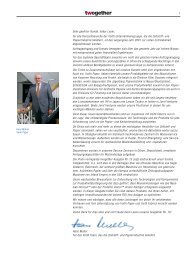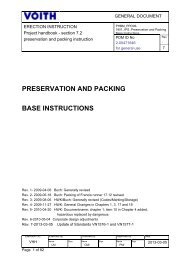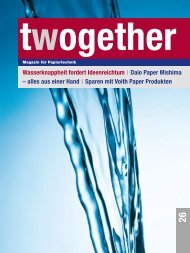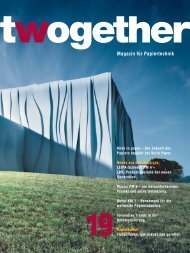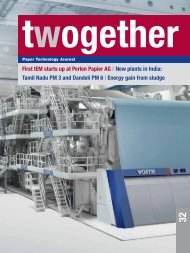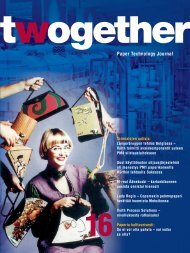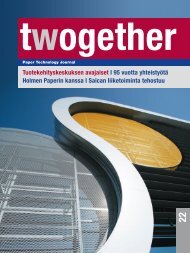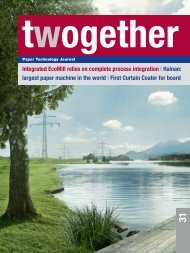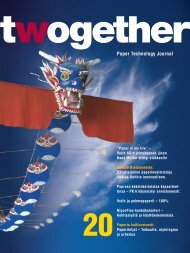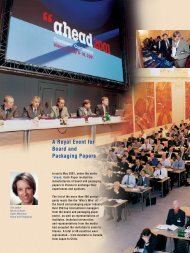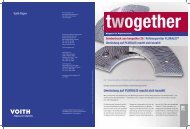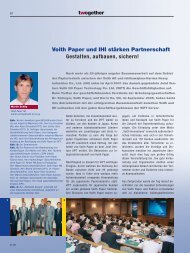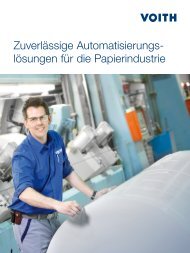Paper Technology Journal 19 - Voith
Paper Technology Journal 19 - Voith
Paper Technology Journal 19 - Voith
You also want an ePaper? Increase the reach of your titles
YUMPU automatically turns print PDFs into web optimized ePapers that Google loves.
the world’s largest EcoCell flotation systems<br />
then ensures efficient removal of<br />
the detached printing inks.<br />
A 4-stage LC screening system provides<br />
economic removal of stickies.<br />
Ahead of the subsequent dispersion stage,<br />
the stock is thickened to a stock consistency<br />
of 30% using both disc filters with<br />
wear-free Bagless segments and screw<br />
presses. A SpeedHeater is used to heat<br />
up and homogenize the stock and to<br />
blend in bleaching agents. In Disperger I,<br />
any printing ink residues still on the fibres<br />
are now detached and optically disturbing<br />
particles are reduced in size to<br />
below the visibility limit. At the same<br />
time, peroxide is added directly in the<br />
disperger for the oxidative bleaching<br />
stage.<br />
The crumbly stock is then fed via a screw<br />
system to a new type of high-consistency<br />
bleaching tower with MC discharge. In<br />
Flotation II the ink particles detached by<br />
dispersion are removed.<br />
At the end of the process, thickening to a<br />
consistency of >30% ensures strict water<br />
separation between DIP and paper machine.<br />
Dispersion II is responsible for a<br />
further homogenization of the DIP stock.<br />
A final reductive bleaching stage ensures<br />
a further increase in brightness.<br />
Special attention has been given to water<br />
cleaning. Each loop has its own Deltapurge<br />
microflotation. The pick-up and<br />
make-up water is also completely cleaned.<br />
ConusTrenner machines in both loops reduce<br />
the ash content in the finished stock<br />
when required.<br />
Fig. 3: Part of the 3D model for DIP 2.<br />
Fig. 4: Partial view of DIP 2.<br />
Fig. 5: Block diagram of DIP 2.<br />
Fig. 6: SpeedSizer.<br />
Tightly-closed circuits can lead to extreme<br />
heating up of the loops. A consequent<br />
philosophy of process cooling using<br />
heat exchangers has therefore been<br />
implemented.<br />
LEIPA’s chosen concept ensures a stock<br />
with optical properties close to that of<br />
virgin fibres. The strength characteristics<br />
needed to meet the requirements of PM 4<br />
are achieved by post-refining of the DIP<br />
stock. The LWC paper produced is certainly<br />
a match for the qualities so far<br />
available on the market.<br />
<strong>Technology</strong> that convinces –<br />
One Platform Concept<br />
The new PM 4 is based on the One Platform<br />
Concept. With the One Platform<br />
Concept the economic efficiency of the<br />
system and the quality of the end product<br />
are of prime importance. The use of<br />
proven and tested modules permits, precisely<br />
with this new, innovative production<br />
process, a maximum of planning certainty<br />
and reliability. With PM 4, an allonline<br />
concept is followed, i.e. precalendering,<br />
coating and calendering take<br />
place online.<br />
The DuoFormer TQv with ModuleJet at<br />
the headbox, which permits a uniformly<br />
controlled CD basis weight profile, is followed<br />
by a TandemNipcoFlex Press. The<br />
wire and press section are equipped with<br />
DuoCleaners for the cleaning of all wires<br />
and felts. The second press is equipped<br />
in the bottom position with a transfer<br />
belt. The ModuleSteam ensures a uniform<br />
moisture profile at the end of the Top-<br />
DuoRun pre-dryer section. The first four<br />
6<br />
13<br />
dryer fabrics have been equipped with<br />
DuoCleaners for optimal cleaning.<br />
ProRelease Stabilizers reduce the web<br />
tension and in this way allow an increased<br />
speed potential. Immediately<br />
after the pre-dryer section follows the<br />
EcoSoft calender for precalendering,<br />
which was, for the first time, designed as<br />
a soft calender for LWC papers. The<br />
EcoSoft calender has 45° inclined framing<br />
(Delta Design) for easier roll changing.<br />
The SpeedSizer coating unit is<br />
equipped with an automatic coat weight<br />
CD profiling device.<br />
The combination of coater, Profilmatic R<br />
control software and the associated actuator<br />
system of the ModuleCoat ensure<br />
that the high demands made on the quality<br />
of the paper are met. Between the two<br />
hot-air dryer hoods is the Module IR infrared<br />
profiling unit. This selectively<br />
eliminates moisture streaks in the CD<br />
profiles after the coating operation.<br />
BASF, one of the world’s leading manufacturers<br />
of paper chemicals, supplied a<br />
tailor-made chemical package for the new<br />
PM 4. It covers the entire process from<br />
the wet end up to the coating station. In<br />
accordance with the basic concept of the<br />
machine, the system idea is in the forefront<br />
also in the case of the chemicals.<br />
The online calender Janus MK 2,<br />
equipped with 10 rolls, ensures maximum<br />
calendering quality. Following this,<br />
the Sirius reel winds parent rolls of up to<br />
3.5 m in diameter.<br />
Via an automatic rail transport system,<br />
the parent rolls are forwarded to the two<br />
<strong>19</strong>/05



